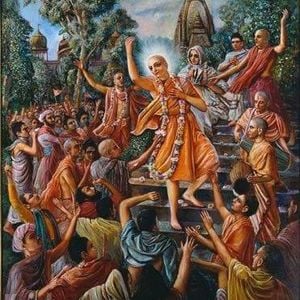

The mantra was popularized by Chaitanya Mahaprabhu roughly around 1500 A.D. No better means than this is to be seen in all the Vedas. Hare Rama Hare Rama, Rama Rama Hare Hare, Hare Krishna Hare Krishna, Krishna Krishna Hare Hare these sixteen names are destructive of the evil effects of Kali. Narada asks to be told this name of Narayana, and Brahma replies: He shakes off (the evil effects of) Kali through the mere uttering of the name of Lord Narayana, who is the primeval Purusha. Hearken to that which all Shrutis (the Vedas) keep secret and hidden, through which one may cross the Saṃsāra (mundane existence) of Kali. In this Upanishad, Narada is instructed by Brahma (in the translation of K.

The mantra is first attested in the Kali-Saṇṭāraṇa Upaniṣad (Kali Santarana Upanishads), a Vaishnava Upanishad written by Raghunandan Bhattacharya. As such anyone can take part in the chanting without any previous qualification. This chanting of 'Hare Krishna, Hare Krishna, Krishna Krishna, Hare Hare / Hare Rama, Hare Rama, Rama Rama, Hare Hare' is directly enacted from the spiritual platform, and thus this sound vibration surpasses all lower strata of consciousness – namely sensual, mental, and intellectual. When we hear the transcendental vibration, this consciousness is revived. Krishna consciousness is not an artificial imposition on the mind this consciousness is the original energy of the living entity. Bhaktivedanta Swami describes the process of chanting the Maha Mantra as follows: "Rama can also be a shortened form of Balarama, Krishna's first expansion." The mantra is repeated, either sung out loud ( bhajan), congregationally ( kirtan), or to oneself aloud or mentally on prayer beads made of Tulasi ( japa). The more common interpretation is that Rāma refers to Rama of the Ramayana, an earlier avatar of Krishna. It is sometimes believed that "Rama" in "Hare Rama" means " Radharamana" or the beloved of Radha (another name for Kṛṣṇa). In the hymn Vishnu Sahasranama spoken by Bhishma in praise of Krishna after the Kurukshetra War, Krishna is also called Rama. Bhaktivedanta Swami Prabhupada, Harā refers to "the energy/shakti of Supreme Personality of Godhead" while Krishna and Rama refer to Supreme Godhead Himself, meaning "He who is All-Attractive" and "He who is the Source of All Pleasure". Another interpretation is as the vocative of Harā, a name of Rādhā, Krishna's eternal consort or His energy (Krishna's Shakti). "Hare" can be interpreted as either the vocative form of Hari, another name of Vishnu meaning "he who removes illusion". She draws her influences from artists such as Shreya Ghoshal, Alka Yagnik, Sunidhi Chauhan, Kanika Kapoor, Neha Kakkar, and many more.Sanskrit is a polysemic language and as such, this mantra has multiple interpretations all of which may be considered as correct.

The singer has released few covers online and has been highly appreciated by many big names of the music industry. The Indian singer has diverse influences, ranging from Bollywood to Sufi and Indian classical.
HARE KRISHNA BHAJAN PROFESSIONAL
Maanya Arora is a professional singer based out of the capital city of India, New Delhi. Watch more: Beautiful Krishna Bhajans with lyrics About Manya Arora Shree Krishna Govind Hare Murari Krishna Bhajan Maanya Arora Divine Chants

RASA Production presents Shree Krishna Govind Hare Murari Hey nath Narayan Vasudeva – Krishna Bhajan by Maanya Arora.


 0 kommentar(er)
0 kommentar(er)
